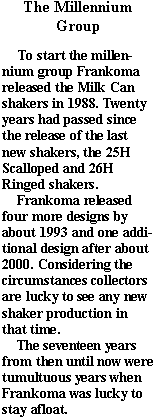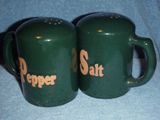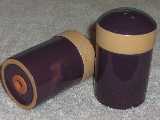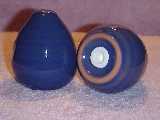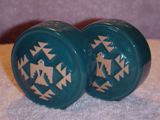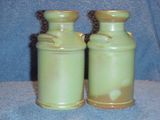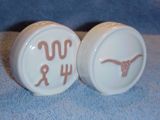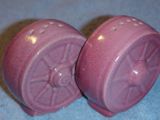

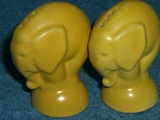
The Millennium Shaker Group
When I started this project I said I would not proceed beyond the point in 1991 where the Frank family lost control of Frankoma. When, however, I saw that the new ownerships (three by now!) had done some interesting things with shakers I took another look. Strangely I find I know less about the millennium shakers than about the other groups.
Joniece Frank introduced the Milk Can shakers in 1988 in a supplement delivered with the 1988 catalog. In 1991 when the ownership changed Frankoma was offering only six shaker sets: the milk cans, the ringed shakers, and the Plainsman, Westwinds, Lazybones, and Myan-Aztec dinnerware shakers.
In the 1992 catalog, the first under new owner Richard Bernstein, Frankoma offered no new shaker designs. The catalog does feature the new Native American and Ranch dinnerware lines, but without shakers. I believe the matching shakers for these llines were introduced in 1993. The 1995 catalog offers almost all of the millennium shakers. In addition to the Native American and Ranch lines a new Stove Top shaker and a new Table Top shakers are offered. At some later date the Mountain Air shakers join the group.
That said, let me make some general observations about this group.The earliest of the millenniums came with the red rubber plug Frankoma had used since the late 1960's. Somewhere around 2000 the new ownership switched to a pure white rubber plug. The new stopper looks nice, but dries up and falls out in about five to ten years.
The glazes used are often not worthy of the Frankoma name. Some shakers have a clear coat applied over a color scheme. This clear coat crazes extensively. Also, now the purchaser of Frankoma shakers is warned not to get them wet! I have not tried it, but I suppose the glaze falls off.
At least some of this group can be dated by the hole set pattern. I will point that out when I consider the individual types. Collectors I believe will be given the job of identifying all of the glazes and shapes used for the millennium group because of the extreme turmoil within the factory structure itself during this period. The records may not be any better than after the two earlier fires.
